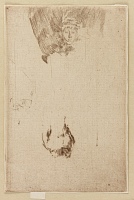Etchings Institutions search term: obach
Two studies of women | ||
| Number: | 271 | |
| Date: | 1886/1887 | |
| Medium: | drypoint | |
| Size: | 123 x 81 mm | |
| Signed: | no | |
| Inscribed: | no | |
| Set/Publication: | no | |
| No. of States: | 1 | |
| Known impressions: | 1 | |
| Catalogues: | K.120; M.127 | |
| Impressions taken from this plate (1) | ||
KEYWORD
head, nude, portrait, woman.
TITLE
There are minor variations on the title for this drypoint but Whistler's original title is not known:
'Sketches of Two Heads' (1909, Howard Mansfield (1849-1938)). 2
'Two slight sketches' (1910, Edward Guthrie Kennedy (1849-1932)). 3
'Two studies of women' (2010, Whistler Etching Project).
The published titles are not accurate. The drypoint does not show two heads, as Mansfield suggests, and the single head is not 'slight', as Kennedy suggests, rather it is very finely worked, although the plate is unfinished. 'Two studies of women' is a brief, descriptive title.
'Sketches of Two Heads' (1909, Howard Mansfield (1849-1938)). 2
'Two slight sketches' (1910, Edward Guthrie Kennedy (1849-1932)). 3
'Two studies of women' (2010, Whistler Etching Project).
The published titles are not accurate. The drypoint does not show two heads, as Mansfield suggests, and the single head is not 'slight', as Kennedy suggests, rather it is very finely worked, although the plate is unfinished. 'Two studies of women' is a brief, descriptive title.
2: Mansfield 1909 (cat. no. 127).
3: Kennedy 1910 (cat. no. 120).
DESCRIPTION
Near the top of the plate is a sketch of the head of a young woman with a fringe, facing front. The light comes from the right, casting shadows behind and to left. Upside down near the bottom of the plate is the torso of a nude woman.
SITTER
Not identified. She looks a little like the sitter for The Little Hat
[366] and also Helen Lenoir (1852-1913), who posed for The Fur Tippet: Miss Lenoir
[365] in late 1886 or 1887.
DISCUSSION
These are mostly unfinished sketches and it is a little hard to tell if the style is Whistler's, because there is so little to go on. It was not recorded in Whistler's lifetime, before it appeared at Obach & Co. in London in 1904.
